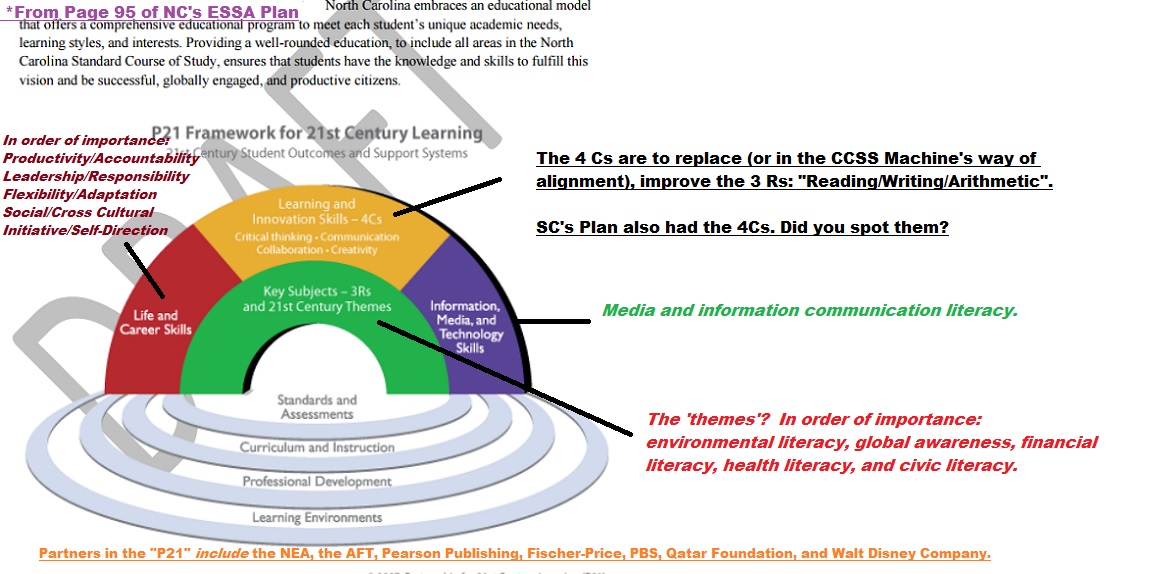My fellow anti CCSS/Fed Ed/ESSA Warriors. I’ve recently finished combing through the NC Draft ESSA (Every Student Succeeds Act) Plan. I’m not a fan of what I read. If your State has released a draft, please get your hands on the information! NC’s is a whopping 145 pages of anything and everything connected to education…and the workforce. I looked up our neighboring State (SC). Theirs is 84 Pages.
I did try to find some other neighboring State’s ESSA Plans as well. Why? I was curious to see just how unique each Plan is shaping up to be. After all, we’ve been told time and time again, ESSA returns control of education back to the States. (*Note: if you’ve followed my blog for a long time, you know how full of BS what we’ve been told is.)
I did see some of the same things in SC’s Plan that I saw in NC’s. Coincedence, no!
Both contain the federal level requirements each State must adhere to.
For example, what type of graduates each State will have. Below is SC’s:

You can find the legislation which made this Profile a SC State Law:
To see and study SC’s ESSA Plan: http://ed.sc.gov/newsroom/every-student-succeeds-act-essa/draft-consolidated-state-plan/
*******************************************************
By contrast, here is NC’s Graphic:

If you have wondered why BOTH NC and SC have the 4Cs (Critical Thinking, Collaboration, Creativity, and Communication), it’s because the P21 (“Partnership for 21st Century Learning Skills”) has both NC/SC as ‘member States'(along with several other States). *Noteworthy: The “Partnership” has been a CCSS Machine member group for quite a while. On the www.P21.org website, you can find 50 College/Career Readiness resources. CCR (College and Career Readiness) is also another name for Common Core State Standards. CCR is embedded in ESSA (Every Student Succeeds Act) ) Find the resources here **Be sure to look for the ‘grit’, ‘workforce readiness in middle school’, and, more.
From Page 25 of NC’s ESSA Draft Plan:
 By July of 2015, NC had a “The Constitutional Mandate to Provide an Opportunity to a Sound Basic Education: An Update and a Recommendation”. Oddly enough, this 2015 Mandate is NOT all that different from the current NC ESSA Plan which will be submitted to the U.S. Dept. of Education later in 2017. To see the mandate, click here. If you’d like to see NC S561, click here. To see NC’s ESSA Plan
By July of 2015, NC had a “The Constitutional Mandate to Provide an Opportunity to a Sound Basic Education: An Update and a Recommendation”. Oddly enough, this 2015 Mandate is NOT all that different from the current NC ESSA Plan which will be submitted to the U.S. Dept. of Education later in 2017. To see the mandate, click here. If you’d like to see NC S561, click here. To see NC’s ESSA Plan
*********************************************************
What We Can Learn From Both NC And SC To Apply Elsewhere:
1) Both had the 5 or 6 federal mandates of ESSA laid out in their Plans.
{These will all be consistent with the Secretary of Education’s authority}:
a) Long-Term Education Goals
b) Consultation/Performance Management toward Long-Term Goals
c) Academic Assessments
d) Accountability and Support for School Improvement
e) Supporting Excellent Educators
f) Supporting All Students
2) Both will continue education which aligns to College/Career Readiness (aka Common Core, Career Tech Education, etc.).
3) Both will continue to update OR create State-level laws to support the educational shift FROM academics to skill based workforce.
4) Both appear to have no plans to cut the ties with the CCSS Machine member organizations we find so entrenched in our lives. (Example: Pearson, P21, Council of Chief State School Officers (CCSSO), etc.)
5) Both will continue to include non-educators in the education process.
6) Both will continue to see Workforce Education efforts and legislation.
7) Both will more than likely continue their membership statuses in P21, CCSSO, and the other CCSS Machine member groups steering the shift in education.
8) Both will continue to workforce skill based assesssments like ACT Aspire, WorkKeys, etc.
**BOTTOM LINE: None of the State ESSA Draft Plans will differ MUCH from what is in place now. What’s in place now IS CCSS/CCR/CTE aligned. It will stay that way, but be called “Challenging State Academic Standards”.
**************************************************
Other Things Of Note From NC’s Plan:
I wanted to leave you with some other key items of interest.
1) U.S. Dept. of Education’s Date Stamp: 12/22/16 (NC’s ESSA Draft Plan expires 11/30/19).
2) From Page 2, ESEA’s (Elementary and Secondary Education Act of 1965) Section 8302 sets out in that the U.S. Secretary of Education is permitted to establish procedures/criteria after consulting with the State officials. Our State Education Agency then submits the Plan. The Secretary must establish every program in Section 8302 including the State’s materials and resources for education. (*Note: ESEA’s Section 8302 is Optional Consolidated State Plans or Applications. ESSA’s Section 1005 is simply titled “State Plans”. Do not be fooled by the simple title.)
2a) Also on Page 2, every State’s Consolidated Education ESSA Plan must create 1 comprehensive way to improve ‘outomes’ for students.
2b) Included in Page 2’s language is that all State Plans must meet the requirements of Section 427 of the General Education Provisions Act. (See a screen shot below)

3) From Page 3 of NC’s ESSA Plan, Only after the U.S. Dept. of Education approves a State Plan, will these Plans be made public. The preferred method for publicity is to be in a published form.
4) Page 4 reveals our State’s Director of Data, Research, and Federal Policy.
5) Page 17 shows the Federal Program for Monitoring and Support Division of the U.S. Dept. of Ed. From this Division, $463,000,000.00 in federal funds for annual grants are available to school districts. (Watch for an increase in data collection). Here in NC, a Senior Leader Council is used to determine which districts/schools receive our portion of these grants. Based on 3 prongs: i) our Comprehensive Continuous Improvement Plan; ii) to be used by LEAs, charter schools, and non-government organizations to receive competitive federal funds, and iii) the NC Equity Plan (from the NC Dept. of Public Instruction) for data collection.
6) Page 25 tells what is considered as ‘academic indicators’. These are also known as ‘measures’. In order: Academic Achievement, Academic Progress, Graduation Rates, English Language Proficiency, School Quality, and Student Success. Page 28 will show you how the ‘meaningful differentation’ used in these indicators simply means ‘distinct and discrete levels of school performance’. (*Note: the shift from student to the entire school being measured.)
7) Page 29, points you to the School Quality or Student Success indicators. They are, in order: chronic absences, attendance, student engagement, student’s participation in co-curricular activities, physical activity, student participation in the arts, suspensions, teacher engagement, parent involvement, End of Grade exams (or End of Course exams) only in science, the CCR Index (College and Career Readiness Index includes AP Courses, IB Courses, WorkKeys Assessments, ACT, and (here in NC) 5 Diploma Endorsements (these are Career and College, UNC College, NC Academic Scholar, and Global Language). From the bottom of Page 29 to the top of Page 30, this “all schools must be included in the accountability system.” What NC hasn’t figured out yet is HOW to update the indicators above for every school type. How well each State does with this determines the weight of the Success Indicator. Federal education code lays this out, NOT a State’s law!
8) Page 30 goes into the 95 % assessment participation rates as mandated in ESSA. How will the States factor this? What data mining/gathering procedures will be used? How will all the schools without sufficient data gathering, or alternative schools (K-12th) be accountable?
9) Page 33 uses a word we’ve all come to loathe: “rigor”. Yes, we’ll see more of it! However, it’s interesting that once again, it’s the ESEA cited here, NOT the ESSA. Related is Page 38 with its mention of NC’s love for UDL (Universal Design for Learning). According to NC, UDL helps ensure all students will be College and Career Ready.
10) Skipping ahead to Page 97 are the “Challenging State Academic Standards for Math” in NC. They will be the EXACT ones used in the 2016-17 academic year!! “Challenging State Academic Standards for English Language Arts”? They haven’t been released yet, as they are still being ‘written’.
A Bonus Item!! Way back in the pages of the NC ESSA Draft Plan is the gold mine of all those CCSS Machine friendly ‘stakeholders’ in education we have wondered about. Pages 137-140 reveal the ESSA external stakeholders in education. Some we know about (example: Teach for America). Some are a bit surprising to see (example: Americans for Prosperity, NC Branch).
Closing:
Warriors, I’ve laid large chunks of evidence before you to illustrate how much of a farce it seems to be that our States will get to control education in the manner in which it has been explained since ESSA was signed into federal law December 2015.
Please take what you see here, start looking at what your State is doing. How similar is it to what you see here? What has remained the same in your State’s education sytem, what has been updated? What groups are involved?




I’d love to have a link to Facebook to share this.
It is not simply the “95 % assessment participation rates… mandated in ESSA” which are problematic, but the fact that this specific stipulation continues to validate the blaming and punishing of our nation’s poorest schools where participation rates are lowest. BLATANT ELITISM AT WORK.